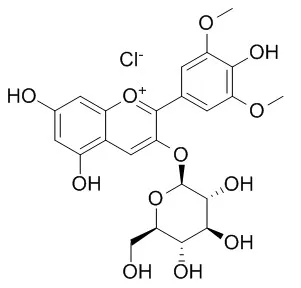| In vitro: |
| J Food Biochem. 2008 Sep 23;32(5):576-596. | | Anthocyanin Interactions with DNA: Intercalation, Topoisomerase I Inhibition and Oxidative Reactions.[Pubmed: 19924259] | Anthocyanins and their aglycone anthocyanidins are pigmented flavonoids found in significant amounts in many commonly consumed foods. They exhibit a complex chemistry in aqueous solution, which makes it difficult to study their chemistry under physiological conditions.
METHODS AND RESULTS:
Here we used a gel electrophoresis assay employing supercoiled DNA plasmid to examine the ability of these compounds (1) to intercalate DNA, (2) to inhibit human topoisomerase I through both inhibition of plasmid relaxation activity (catalytic inhibition) and stabilization of the cleavable DNA-topoisomerase complex (poisoning), and (3) to inhibit or enhance oxidative single-strand DNA nicking. We found no evidence of DNA intercalation by anthocyan(id)ins in the physiological pH range for any of the compounds used in this study-cyanidin chloride, cyanidin 3-O-glucoside, cyanidin 3,5-O-diglucoside, Malvidin-3-O-glucoside chloride and luteolinidin chloride. The anthocyanins inhibited topoisomerase relaxation activity only at high concentrations (> 50 muM) and we could find no evidence of topoisomerase I cleavable complex stabilization by these compounds.
CONCLUSIONS:
However, we observed that all of the anthocyan(id)ins used in this study were capable of inducing significant oxidative DNA strand cleavage (nicking) in the presence of 1 mM DTT (dithiothreitol), while the free radical scavenger, DMSO, at concentrations typically used in similar studies, completely inhibited DNA nicking.
Finally, we propose a mechanism to explain the anthocyan(id)in induced oxidative DNA cleavage observed under our experimental conditions. |
|






 Cell. 2018 Jan 11;172(1-2):249-261.e12. doi: 10.1016/j.cell.2017.12.019.IF=36.216(2019)
Cell. 2018 Jan 11;172(1-2):249-261.e12. doi: 10.1016/j.cell.2017.12.019.IF=36.216(2019) Cell Metab. 2020 Mar 3;31(3):534-548.e5. doi: 10.1016/j.cmet.2020.01.002.IF=22.415(2019)
Cell Metab. 2020 Mar 3;31(3):534-548.e5. doi: 10.1016/j.cmet.2020.01.002.IF=22.415(2019) Mol Cell. 2017 Nov 16;68(4):673-685.e6. doi: 10.1016/j.molcel.2017.10.022.IF=14.548(2019)
Mol Cell. 2017 Nov 16;68(4):673-685.e6. doi: 10.1016/j.molcel.2017.10.022.IF=14.548(2019)